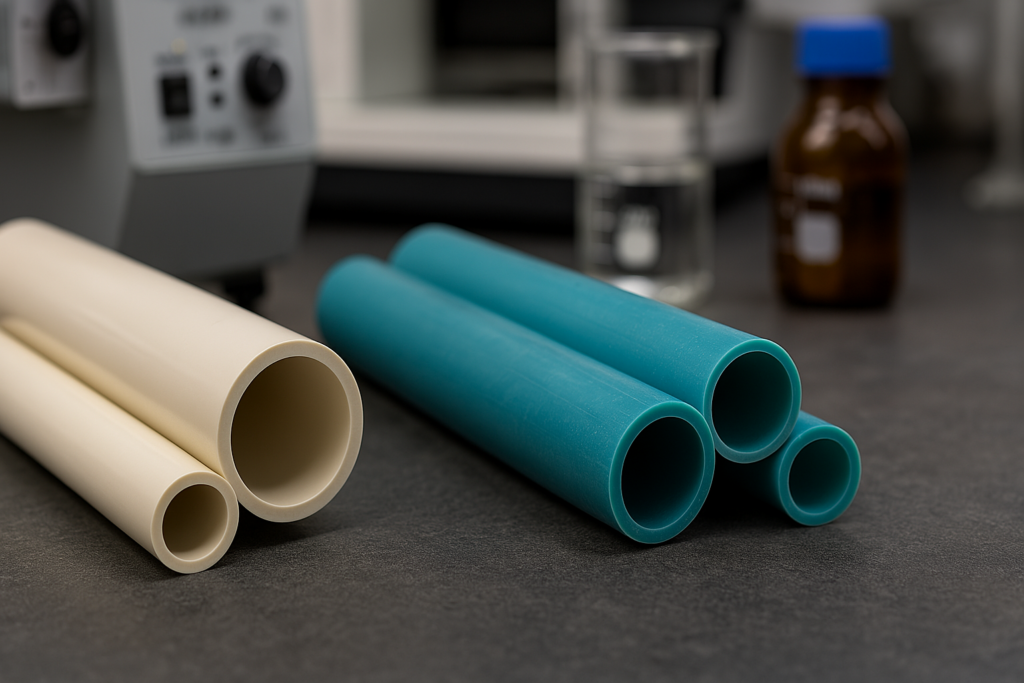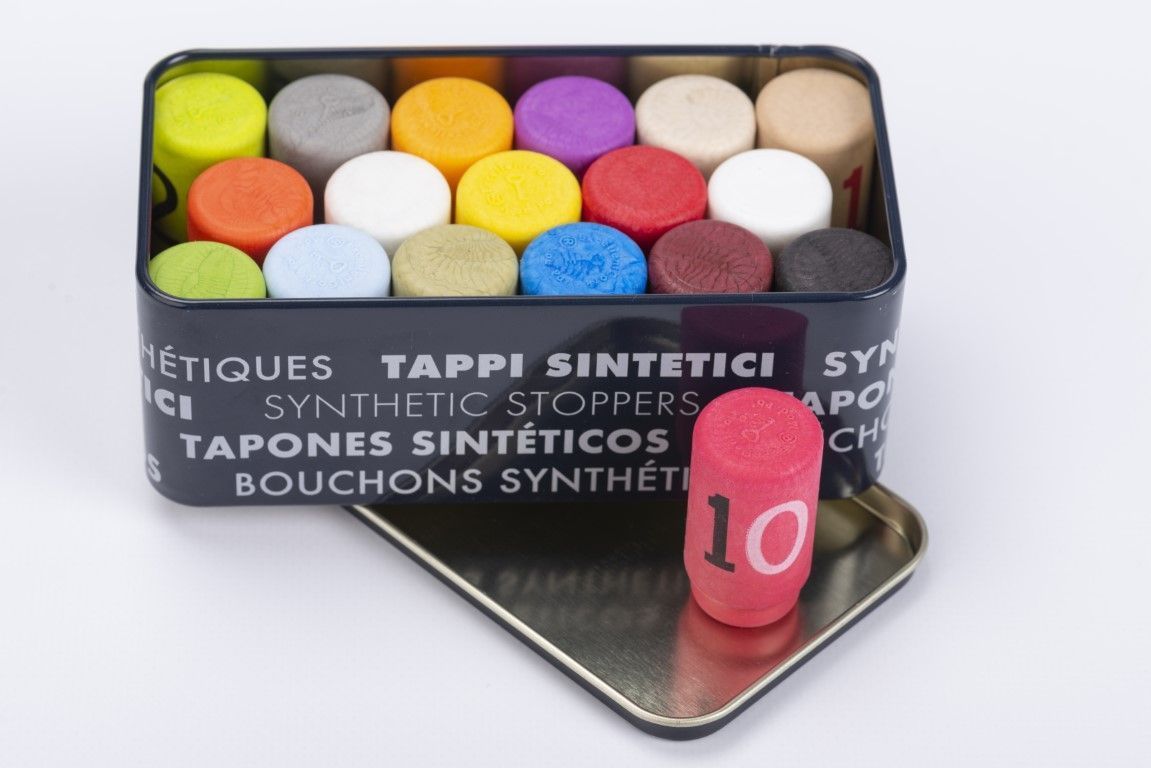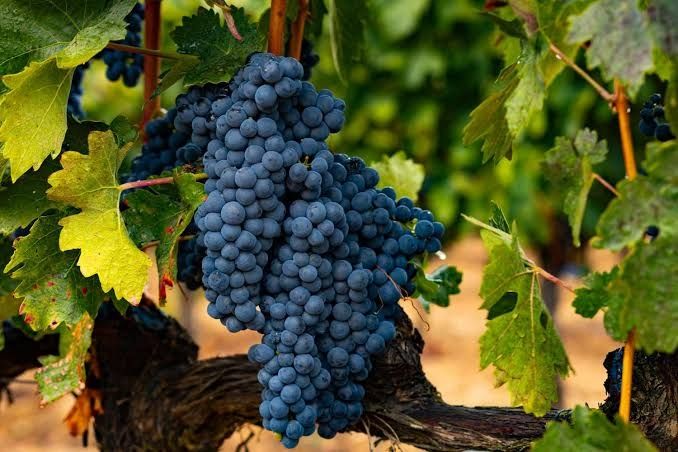PVC (polyvinyl chloride) and polyethylene are two of the most widely used plastic materials in the industry due to their diverse applications and specific properties. Although both fall under the category of thermoplastic polymers, they present fundamental differences in their chemical composition, molecular structure, and mechanical behavior. These differences affect their resistance, flexibility, durability, and specific applications in sectors such as construction, packaging, automotive, and chemical industries.
In this article, we will explore in detail the main differences between these materials, their advantages and disadvantages, and in which situations it is more advisable to use each one.
What is PVC (polyvinyl chloride)?
PVC is a thermoplastic material obtained through the polymerization of vinyl chloride. Its molecular structure contains chlorine atoms, which give it specific properties such as high corrosion resistance, low thermal conductivity, and notable fire resistance. Additionally, its versatility allows its composition to be modified by adding plasticizers and stabilizers, resulting in different material variations.
Depending on its formulation and structure, PVC can be classified into two main types:
- Rigid PVC: A hard and durable material widely used in water and gas pipes, window frames, credit cards, construction panels, and pharmaceutical packaging. Its durability and chemical resistance make it ideal for structural and long-lasting applications.
- Flexible PVC: Obtained by adding plasticizers, giving it a softer and more malleable texture. It is used in electrical cables, flooring, coated fabrics, toys, and hoses. Its flexibility makes it suitable for applications requiring mechanical resistance combined with adaptability.
Thanks to its versatility and specific properties, PVC is one of the most in-demand plastics in modern industry.
If you’re interested in innovative technical solutions for products like bottles or secure closure packaging, we recommend exploring our synthetic closure range. Their high chemical resistance makes them an ideal alternative to PVC in certain applications.
What is polyethylene?
Polyethylene is a thermoplastic polymer derived from ethylene, characterized by its simple molecular structure, high flexibility, and impact resistance. It is one of the most widely used plastics in the world due to its low production cost and wide range of applications.
Unlike PVC, polyethylene does not contain chlorine in its composition, giving it greater chemical stability and easier recyclability. Its molecular structure allows it to adopt different density grades, resulting in various types of polyethylene, each with specific characteristics according to its application.
It is classified into several categories based on its density and mechanical properties, including:
- Low-density polyethylene (LDPE): A flexible, lightweight material with high moisture resistance. It is mainly used in the production of plastic bags, packaging films, flexible containers, and waterproof coatings.
- High-density polyethylene (HDPE): With a more compact molecular structure, making it more resistant and durable. It is used in pipes, rigid containers, industrial bins, toys, and automotive components.
Thanks to its mechanical resistance and ability to withstand extreme conditions, polyethylene is widely used in modern industry, especially in applications requiring high durability and chemical resistance.
Types of polyethylene by density
Low-density polyethylene (LDPE)
LDPE is known for its high flexibility, low crystallinity, and moisture resistance. Its molecular structure features branched chains, reducing its density and increasing elasticity. Due to these properties, it is widely used in the production of plastic bags, packaging wraps, flexible bottles, and waterproof coatings. It is also used in the industrial sector for electrical insulation and irrigation pipes.
High-density polyethylene (HDPE)
HDPE is a denser and more structurally compact material than LDPE. It has high mechanical strength, stiffness, and durability, making it ideal for applications requiring robustness. It is used in the manufacture of water and gas pipes, rigid chemical containers, drums, toys, and automotive components. Its low permeability to chemicals and abrasion resistance make it suitable for demanding industrial environments.
Structural differences between PVC and polyethylene
Chemical composition
PVC contains chlorine in its molecular structure, giving it flame-retardant properties and higher chemical resistance to certain solvents and oils. This element also affects its degradation behavior, making it less environmentally sustainable if not properly recycled.
In contrast, polyethylene is composed exclusively of carbon and hydrogen atoms, making it lighter and more flexible. Lacking chlorine, it presents a more stable structure and is safer for recycling, making it a more eco-friendly option compared to PVC.
Molecular structure and physical properties
PVC has a more ordered and compact structure, which provides greater rigidity and mechanical resistance. Its high density and chemical stability make it ideal for applications requiring durable materials with high pressure resistance, such as pipes and structural profiles.
In contrast, polyethylene has a more flexible and less dense structure, giving it greater impact and deformation resistance. Depending on its density, it can be used in both flexible (LDPE) and rigid, high-resistance applications (HDPE).

Physical and mechanical properties
Physical and mechanical properties of PVC
- High mechanical resistance: Its dense structure gives it great resistance to mechanical stress and heavy loads.
- Rigidity: Due to its molecular composition, rigid PVC maintains its shape without deformation under pressure.
- Low permeability to gases and liquids: Its compact structure prevents the penetration of gases and liquids, making it ideal for pipes and industrial containers.
- Chemical resistance: It tolerates contact with acids, bases, and solvents well, making it suitable for harsh industrial environments.
- Durability: Its weather and degradation resistance make it ideal for long-term applications.
Physical and mechanical properties of polyethylene
- High flexibility and toughness: Its molecular structure allows for great deformation capacity without breaking.
- Impact resistance: Especially in its high-density form (HDPE), it can absorb impacts without fracturing.
- Low density: A lightweight material, making it easy to handle and reducing transportation costs.
- Impermeability: Acts as a barrier against moisture and is highly resistant to water absorption.
- Chemical resistance: Unaffected by most common chemicals, including solvents and weak acids.
- Malleability: Easily molded into various shapes and thicknesses depending on the application.
Chemical and thermal resistance
PVC is highly resistant to certain chemicals, including acids, bases, and oils, making it suitable for industrial and chemical fluid applications. Additionally, its chlorine content gives it flame-retardant properties, meaning it doesn’t ignite easily and self-extinguishes when the heat source is removed.
On the other hand, polyethylene stands out for its excellent resistance to extreme temperatures, especially in its high-density variant (HDPE), which can withstand low temperatures without becoming brittle. However, polyethylene is more flammable than PVC and can burn easily unless flame-retardant additives are added.
Common applications
Common applications of PVC
PVC is a versatile and durable material widely used in industrial and construction sectors due to its longevity and weather resistance. Some of its most common uses include:
- Pipes and conduits: Used in potable water distribution, drains, and irrigation systems due to its corrosion resistance and long lifespan.
- Window and door profiles: Frequently used in carpentry thanks to its thermal insulation and moisture resistance.
- Electrical cable coatings: Protects conductors thanks to its fire resistance and mechanical wear resistance.
- Plastic cards: Used in the manufacture of bank cards, IDs, and licenses due to its rigidity and printability.
- Flooring and coverings: Used in vinyl floors and decorative panels due to wear resistance and ease of cleaning.
Common applications of polyethylene
Polyethylene, due to its flexibility, low weight, and high impact resistance, has a wide range of uses across industries. Some of its notable applications include:
- Plastic bags and containers: Used in supermarkets, food packaging, and flexible packaging due to its low cost and ease of production.
- Tanks and containers: Being waterproof and resistant to chemicals, it’s used for water tanks, industrial drums, and liquid product containers.
- Industrial parts: Used in the manufacture of gears, bearings, and technical parts due to its low friction and mechanical resistance.
- Automotive components: In bumpers, interior panels, and fuel tanks due to its lightness and impact absorption.
- Flexible pipes and irrigation systems: Used in agriculture for their moisture resistance and flexibility.
Advantages and disadvantages of each material
Below is a comparison of the main characteristics of PVC and polyethylene:
| Characteristic | PVC | Polyethylene |
|---|---|---|
| Mechanical resistance | High | Medium |
| Flexibility | Medium | High |
| Chemical resistance | High | Medium |
| Thermal resistance | Medium | High |
| Recyclability | Medium | High |
| Weight | Medium | Low |
| Flammability | Low (self-extinguishing) | High |
| Production cost | Medium | Low |
PVC is ideal for applications requiring structural strength and low permeability, while polyethylene is better suited for applications where flexibility, lightness, and impact resistance are needed.
At Excellent Cork, we are committed to sustainable materials like recyclable polyethylene. If you share this vision, don’t miss our section on sustainability and innovation, where we explain how our processes contribute to a greener future.
Frequently Asked Questions
What is the main difference between PVC and polyethylene?
The main difference lies in their chemical composition: PVC contains chlorine, while polyethylene is made only of carbon and hydrogen.
Which is more resistant to high temperatures?
Polyethylene, especially in its high-density versions, is more resistant to high temperatures than PVC.
Which is more eco-friendly?
Polyethylene is easier to recycle and produces less toxic waste than PVC.
Are PVC and polyethylene recyclable?
Yes, but polyethylene is easier to recycle due to its simpler chemical structure.
Which is better for pipes and conduits?
PVC is more suitable for pipes and conduits due to its rigidity and chemical resistance.





